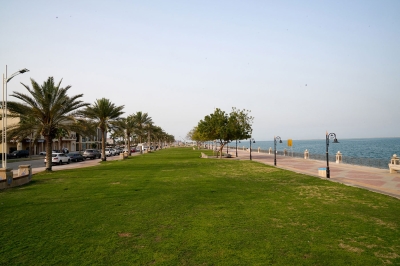




The Maritime Zones in the Kingdom of Saudi Arabia are the maritime areas defined by the Kingdom's sovereignty over three bodies of water: the Arabian Gulf, the Red Sea, and the Gulf of Aqaba. These zones are governed by international maritime law and the Kingdom's internal regulations.
Maritime zones sections in the Kingdom
Internationally, maritime zones are divided into: internal waters, the exclusive economic zone, the contiguous zone, the territorial sea, and the continental shelf. They are defined based on maritime baselines established according to geographical coordinates and the World Geodetic System.
Areas of Maritime zones in the Kingdom
The Kingdom's maritime zones span about 230,900 km², including around 195,400 km² in the Gulf of Aqaba and the Red Sea, and about 35,500 km² in the Arabian Gulf.
The total number of maritime baselines in the Kingdom is 103, located in the Gulf of Aqaba and the Red Sea. These start from a baseline on the maritime border between the Kingdom and the Hashemite Kingdom of Jordan in the Gulf of Aqaba to a baseline on the maritime border between the Kingdom and the Republic of Yemen in the Red Sea. Additionally, there are eleven baselines in the Arabian Gulf, starting from a baseline on the dividing line of the submerged zone adjacent to the partitioned area between the Kingdom and the State of Kuwait to a baseline on the maritime border between the Kingdom and the Kingdom of Bahrain. The Kingdom and the State of Qatar share about four maritime baselines, starting from a baseline on the maritime border beyond Khawr al-Udayd to a baseline at the coastal border between the Kingdom and the United Arab Emirates. These baselines are recognized by the United Nations, with the lists deposited in 2010. The baselines define the internal waters zone, which lies between the coast and these baselines. From these points, the width of the territorial sea, the contiguous zone, the exclusive economic zone, and the continental shelf are measured in accordance with international law. The total area of internal waters is approximately 79,200 km², with 66,200 km² in the Red Sea and Gulf of Aqaba, and thirteen thousand km² in the Arabian Gulf. The territorial sea follows, with a total area of about 47,700 km², including 36,200 km² in the Gulf of Aqaba and the Red Sea, and 11,500 km² in the Arabian Gulf. The exclusive economic zone covers approximately 104,000 km², with 93,000 km² in the Gulf of Aqaba and the Red Sea, and eleven thousand km² in the Arabian Gulf.
Territorial sea and the contiguous zone of the Kingdom
The territorial sea, under international maritime law, is a zone that grants the Kingdom legal sovereignty while neighboring countries have the right of innocent passage through it in accordance with international law and the United Nations Convention of 1982. The contiguous zone is also considered part of the exclusive economic zone and extends approximately twelve NM from the outer edge of the territorial sea. This zone is designated for the enforcement of the Kingdom's internal regulations and laws related to security, environmental protection, navigation, taxation, customs, immigration, and health.
The Kingdom's maritime sovereignty
The Kingdom enjoys exclusive sovereignty in the area defined between the contiguous zone and the maritime borders of neighboring states. This sovereignty grants the Kingdom the right to explore living and non-living natural resources, as well as to establish laws for their protection and conservation.
Additionally, the seabed of the exclusive economic zone is considered the property of the Kingdom and is known as the continental shelf. This includes submerged areas and their subsoil. The Kingdom exercises absolute sovereignty over this zone for the purposes of exploration, drilling, and exploitation of natural resources.
Related quizzes
Related articles

